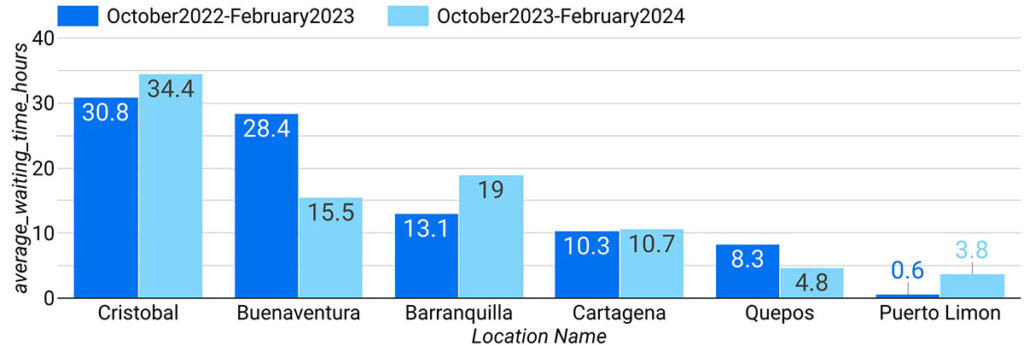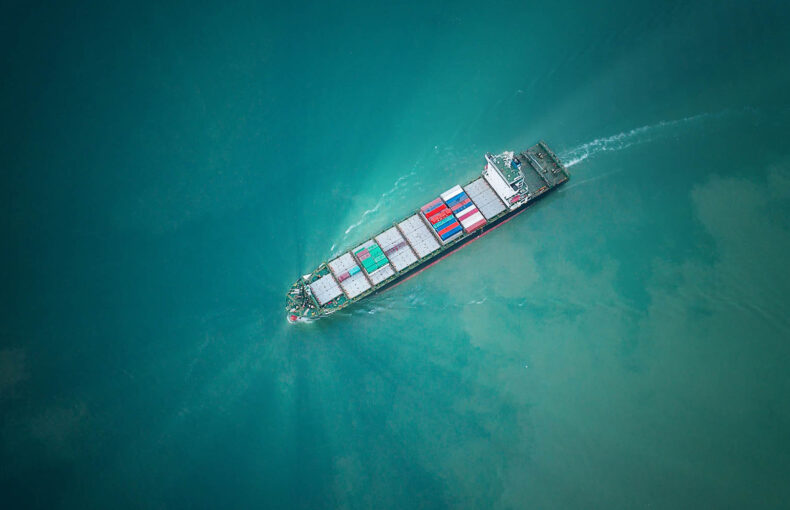The causes and impacts of the Panama Canal drought
Using Spire Maritime, Weather and Climate data, the root causes of the Panama Canal drought have been put to light.
The water scarcity, affecting the canal watershed, has led the Panama Canal Authority to impose restrictions on the number of vessels that are allowed to transit through the canal at any given time, costing Panama $100 million per month in missed toll revenues, according to Reuters.
Using a set of different data sources from Spire, including Historical AIS, Port Events and surface soil moisture anomalies data, it provides a clearer picture of the effects of the drought on maritime traffic in and around the canal.
The importance of the Panama Canal for shipping and world trade
The Panama Canal is an 82 kilometer long shipping artery cutting through Panama connecting the Atlantic with the Pacific Ocean. Its geolocation is essential for global trade and without it, ships would be forced to sail around South America and use the more treacherous routes along Cape Horn or through the Suez Canal. And thus, the Panama Canal is still the most viable route as vessels can transit in less than 24 hours, adding value to supply chains by reducing time, distance, and cost.
Over the past decade, the capacity of the Panama Canal has doubled as a result of the introduction of a new set of locks at each side of the canal. These new locks, not only allow for increased traffic but are also capable of processing bigger vessels. According to a 2016 New York Times article, canal officials ignored warnings that new sources of water would be required for the canal expansion to succeed.
The Panama Canal and its water issues today
A major part of the Panama Canal consists of the Gatun Lake. The Gatun lake is an artificial freshwater lake at 26 metres above sea level, created in 1913 by damming the Chagres River. Locks have been built on each side of the Panama Canal, lifting ships up from the ocean to the Gatun Lake and then lower them again at the other end.
Although the canal connects two oceans, its operation depends upon fresh water from the Gatun Lake, which has been dwindling in recent years due to a lack of rainfall. The drought has been further exacerbated by the effects of an ongoing El Niño. As a result, there is not as much water for vessels to sail through the canal, or for the daily water needs of the surrounding local communities. Furthermore, water is lost to the oceans per downward lock movement, leading to water shortages during the dry season. Each vessel transiting through the canal uses around 52 million gallons of freshwater to lift it in and lower it out of the canal.
Spire data explains drought in the Panama Canal
Remote sensing*, in this case through satellites, provides continuous data in time and space to monitor and understand the spatial distribution of drought conditions, as opposed to ground-based observations.
Different types of droughts exist, meteorological drought (i.e. prolonged period of less than average rainfall in a given region), which generally precedes agricultural drought (i.e. reduced crop production due to insufficient soil moisture), and hydrological drought (i.e. below-normal water availability in rivers, streams, reservoirs, lakes, or groundwater).

Spire’s proprietary soil moisture product has been used to monitor the onset and evolution of drought in the Panama Canal region. Daily soil moisture conditions, as well as decadal soil moisture anomalies are shown for different years, in the plot above. As a reference, the average soil moisture behaviour (i.e. daily mean across all years) is represented through the black line, with its corresponding standard deviation interval shown by the grey banner.
Soil moisture conditions for the Panama Canal zone show early spring as being the driest period, followed by a steady increase of soil moisture throughout the year. A considerable drop in values is noticeable at the onset of winter.
Negative anomalies** are usually associated with drought conditions. The drought conditions are clearly visible in the soil moisture anomalies, with 2023 by far being the driest, with a clear difference compared to other years. Moreover, April and May, which typically represent the onset of the rain season in Panama, shows a significant difference both in soil moisture and soil moisture anomalies levels for 2023, as compared to previous years. This trend continued throughout the summer months of 2023, which matches the reported conditions of last year being one of the driest two years on record. In particular, we see up to 30% decrease in daily soil moisture conditions in summer months, as compared to the historical average.
Furthermore, as of 2000, deforestation through growth of human population, land degradation, and overhunting continued to be threats to the ecosystems of the Panama Canal watershed, causing erosion, which raises the bottom of the Gatun and the adjacent Alajuela Lake, lowering their water holding capacity. And low water levels in the Panama Canal, it’s locks, and adjacent lakes, means less vessel traffic capacity, not just in terms of the number of vessels, but also the draft of the vessels.
Impact of the Panama Canal drought on maritime traffic
The drought that began last year has forced authorities to slash ship crossings to 24 crossings a day compared to 38 daily crossings in normal times, a 36% reduction. Comparing the time period from October 2023 to February 2024 with the same period a year earlier, using Historical AIS, Spire Maritime data shows a 21% drop in traffic going through the Panama Canal. In real terms this equates to 745 less vessels using the canal to sail from the Atlantic to the Pacific Ocean and vice versa.
3526 vessels
2781 vessels
Difference: 745 / 21% less
This comes at a time when traffic through the Suez Canal, another major trade route, is also severely disrupted and no longer acts as a viable alternative for traffic between the east coast of the American continent and Asia. Global shipping company Maersk for example announced earlier this year that they would use the existing Panama Canal Railway as an alternative solution to transport containers across Panama in order to ensure continued trade between Asia, Oceania and the American east coast.
The restrictions imposed by Panama have led to delays, increased shipping costs, and uncertainty over the future of one of the world’s critical trade arteries. In previous periods of drought affecting the Panama Canal, weight restrictions were imposed because heavier vessels risk running aground in the shallower waters.
Spire Maritime’s Port Events data also shows that the current restrictions have resulted in an increased amount of port calls at ports located on both sides of the Isthmus of Panama, namely in Panama, Costa Rica, and Columbia.
Number of unique ships visiting ports:

These increased numbers of vessels calling at ports relatively close to the Panama Canal, have not necessarily resulted in increased waiting times in anchorage areas. Interestingly, however, Spire Maritime data shows that anchorage areas with increased waiting times are mostly located on the Atlantic side of the Panama Canal. Ports such as Cristobal, located at the entrance of the Panama Canal, Barranquilla in Columbia, and Puerto Limon in Costa Rica all have recorded higher waiting times. The issues surrounding the Suez Canal might partly explain this trend as maritime companies are hesitant to use the Red Sea as an alternative route between the Americas and the Asia Pacific region, and rather wait to cross the Panama Canal.
Average waiting time in anchorage areas:

Uncertainty over the future of the Panama Canal
The locks constructed as part of the Panama Canal expansion project, were fitted with water-saving basins. These water-saving basins helps to reduce the volume of water that is needed in lock operation. The new locks have not been able to fully resolve the drought issues the canal is currently facing.
Several options are being analysed to safeguard the continued growth and ensure smooth operations of the Panama Canal. One of the options would be to create a new water reservoir on the Indio River, west of the Gatun Lake. Some current laws, however, prohibit the construction of new or expansion of existing water reservoirs in watersheds beyond the ones that feeds the Panama Canals’ existing lakes.
The Panama Canal Authority is also investigating the feasibility to use water from the Bayano Lake, but tapping water from it, would involve piping water for miles, and possibly jeopardising Panama City’s hydroelectricity supply.
Another measure to reduce the risk of water shortages in the Panama Canal watershed, especially after years of deforestation is forest restoration. In parallel, research is being carried out to get a better understanding into which planting strategies best support the forest’s sponge effect to retain water.
Gloria Arrocha Paz, a meteorologist at the Panama Canal Authority, said in a New York Times article that ‘Whatever can be done inside the Panama Canal watershed is not going to be enough for the next 50 years’ considering the forecasted increase in vessel traffic and the population growth, both needing ever more water.
Learn more about Spire Maritime’s AIS data sets
Get in touch with us for more information on Historical AIS or Port Events data, some of which are unique data solutions only available from Spire Maritime.
*Remote sensing is the acquisition of data about an object or phenomenon without making physical contact, in this case through satellites.
**Soil moisture anomalies are a useful indicator to understand the current soil moisture conditions in the context of climatological trends, since it represents the deviation of the current conditions in terms of water availability.
 Written by
Written by


